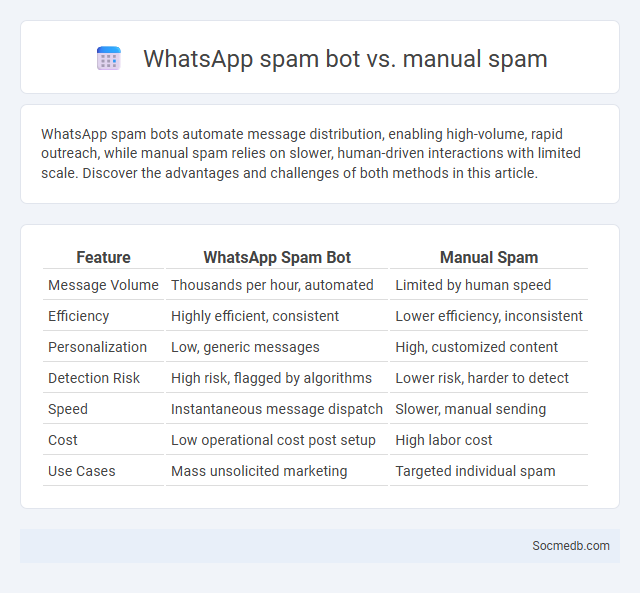
Photo illustration: WhatsApp spam bot vs manual spam
WhatsApp spam bots automate message distribution, enabling high-volume, rapid outreach, while manual spam relies on slower, human-driven interactions with limited scale. Discover the advantages and challenges of both methods in this article.
Table of Comparison
| Feature | WhatsApp Spam Bot | Manual Spam |
|---|---|---|
| Message Volume | Thousands per hour, automated | Limited by human speed |
| Efficiency | Highly efficient, consistent | Lower efficiency, inconsistent |
| Personalization | Low, generic messages | High, customized content |
| Detection Risk | High risk, flagged by algorithms | Lower risk, harder to detect |
| Speed | Instantaneous message dispatch | Slower, manual sending |
| Cost | Low operational cost post setup | High labor cost |
| Use Cases | Mass unsolicited marketing | Targeted individual spam |
Introduction to WhatsApp Spam
WhatsApp spam involves unsolicited messages, often containing scams, promotions, or malicious links, targeting users to exploit their personal information or disrupt their experience. You can protect your privacy by enabling WhatsApp's built-in spam filters and reporting suspicious contacts immediately. Staying informed about common spam tactics on platforms like WhatsApp helps maintain your online security and communication integrity.
Understanding WhatsApp Spam Bots
WhatsApp spam bots automate the sending of unsolicited messages, often aiming to promote scams, phishing, or fake offers. These bots exploit WhatsApp's messaging platform by using fake profiles and bulk messaging techniques to reach a large audience rapidly. Understanding their behavior helps users and developers implement effective spam filters and enhance privacy settings to mitigate threats.
Manual Spam Techniques on WhatsApp
Manual spam techniques on WhatsApp involve sending unsolicited messages individually or in small batches to avoid detection. Spammers exploit features like contact synchronization and group invites to distribute promotional content or phishing links with minimal automation. Users should be cautious of unknown contacts and avoid clicking suspicious links to prevent falling victim to such manual spam tactics.
Key Differences: Bots vs. Manual Spam
Bots on social media automate interactions by rapidly posting spam, liking, or following accounts, often using algorithms to mimic human behavior. Manual spam involves individuals personally sending unwanted messages or comments, making it more targeted but slower in scale. Your ability to detect the difference enhances platform security and ensures genuine engagement.
Common Characteristics of WhatsApp Spam
WhatsApp spam typically involves unsolicited messages sent in bulk, often containing phishing links, fraudulent offers, or malware attachments designed to compromise your privacy and security. These messages exploit WhatsApp's widespread use and encryption, making it essential for you to recognize signs such as unexpected requests for personal information or suspicious links. Identifying common characteristics like urgent language, unknown senders, and unexpected multimedia files helps safeguard your account against spam-related threats.
Detection of Bot-Based vs. Manual Spam
Detecting bot-based spam on social media involves analyzing patterns such as high-frequency posting and repetitive content, which differ significantly from manual spam that often appears more context-aware and varied. Advanced machine learning algorithms utilize metadata like posting timestamps, user interaction ratios, and linguistic nuances to distinguish automated activity from human behavior effectively. You can improve platform security by employing these detection techniques that identify and mitigate the impact of both bot-driven and manual spam.
Risks and Impacts of WhatsApp Spam
WhatsApp spam exposes users to phishing attacks, malware distribution, and privacy breaches, significantly increasing cybersecurity risks. The widespread sharing of unsolicited messages leads to misinformation spread and reduced user trust in the platform. Businesses and individuals face potential data theft, fraudulent schemes, and disruptions in communication efficiency due to spam proliferation on WhatsApp.
Prevention Strategies for WhatsApp Spam
Effective prevention strategies for WhatsApp spam include enabling two-step verification, which adds an extra layer of account security by requiring a PIN during login attempts. Users should avoid clicking on suspicious links and regularly update privacy settings to restrict who can add them to groups or send messages. Reporting and blocking spam contacts promptly helps WhatsApp improve its spam detection and reduce unwanted messages.
Legal Implications of WhatsApp Spamming
WhatsApp spamming violates privacy laws and anti-spam regulations such as the GDPR and CAN-SPAM Act, leading to potential fines and legal actions. Businesses using WhatsApp for marketing must obtain explicit user consent and provide opt-out options to comply with legal standards. Non-compliance can result in account suspension, reputational damage, and civil lawsuits under consumer protection laws.
Future Trends in WhatsApp Spam Detection
Emerging machine learning models are enhancing WhatsApp spam detection by leveraging advanced natural language processing to identify spam patterns and malicious links with higher accuracy. Integration of behavioral analytics helps detect anomalous user activities indicative of spam, enabling proactive filtering before messages reach recipients. Future trends also include blockchain-based verification methods to ensure message authenticity and reduce spoofing in WhatsApp communications.
 socmedb.com
socmedb.com